Warden Protocol Revolutionizes Web3 Development with Modular Layer 1 Blockchain
- Warden Protocol is pioneering a modular infrastructure to make Web3 development seamless.
- The team highlights the challenges of building on Web3 and their solutions to simplify the process.
- David Pinger reveals the benefits of their infrastructure and its potential impact on the decentralized application ecosystem.
Discover how Warden Protocol is transforming the Web3 development landscape with its supercharged modular infrastructure.
Warden Protocol: Revolutionizing Web3 Development
Warden Protocol is set to redefine the landscape of Web3 by introducing a cutting-edge modular infrastructure. This evolution is poised to simplify the process of building decentralized applications, known as OApps, by utilizing a unique approach that abstracts complex elements such as cross-chain interoperability and cryptography. According to David Pinger, co-founder of Warden Protocol, the goal is to empower developers to focus on innovation rather than navigating the intricate aspects of blockchain technology.
The Innovation of Modular Architecture
At the core of Warden Protocol’s offering is its modular architecture, designed to unbundle the blockchain’s application layer to enhance security and flexibility. This design separates the protocol-layer security from application-layer security, allowing developers to implement varied security models for their applications. By aggregating multiple wallets and accounts into a singular interface, the chain abstraction feature enables seamless transactions across multiple blockchains. This not only simplifies the development process but also opens new possibilities for decentralized applications.
Incentivized Testnet Leadership and User Engagement
Warden Protocol recently unveiled its Incentivized Testnet Leaderboard, aiming to engage users through a gamified onboarding process. Participants create profiles and complete various quests to earn WARP tokens, which serve as a liquid representation of leaderboard rewards. These activities not only make users eligible for future airdrops of the WARD ecosystem token but also foster a dynamic and interactive experience. Pinger emphasized that the quest dashboard allows users to accumulate experience points by engaging in both on-chain and off-chain activities, which can then be converted to WARP tokens.
Future of Omnichain Decentralized Applications
Interoperable and chain-abstracted OApps are expected to surpass the capabilities of current Web3 applications. Warden Protocol aims to support the creation of new applications that can operate across multiple networks seamlessly. Potential use cases include exchanges capable of cross-network trading, lending applications utilizing assets from various chains as collateral, and tokenized real-world asset applications that leverage liquidity across multiple blockchains. These innovations promise to pave the way for a more integrated and versatile Web3 ecosystem.
Conclusion
Warden Protocol’s approach to simplifying Web3 development through its supercharged modular infrastructure is poised to make a significant impact on the decentralized application landscape. By offering tools that abstract away the complexities of blockchain technology, Warden Protocol enables developers to concentrate on creating innovative and scalable applications. With the launch of the Incentivized Testnet Leaderboard and the focus on a seamless omnichain experience, Warden Protocol is setting new standards for user engagement and application development in the Web3 space.






![Bitcoin’s [BTC] Market Dominance Dips Amid Price Decline and Rising OTC Reserves](https://i0.wp.com/en.coinotag.com/wp-content/uploads/2024/05/cryptocurrencies-19.webp?fit=1792%2C1024&%23038;quality=70&%23038;ssl=1)